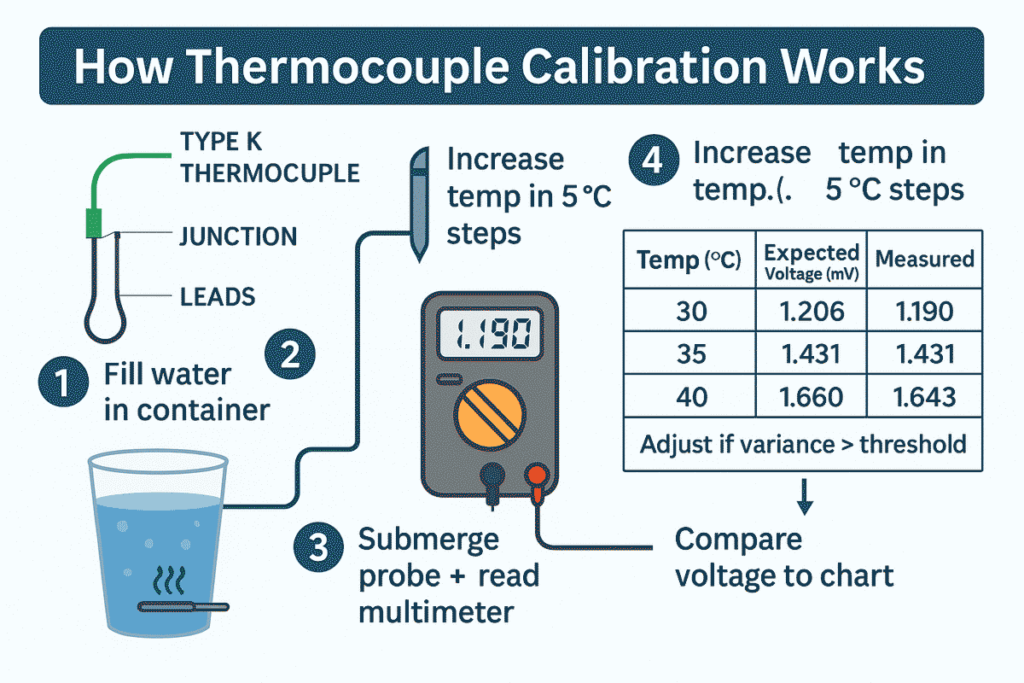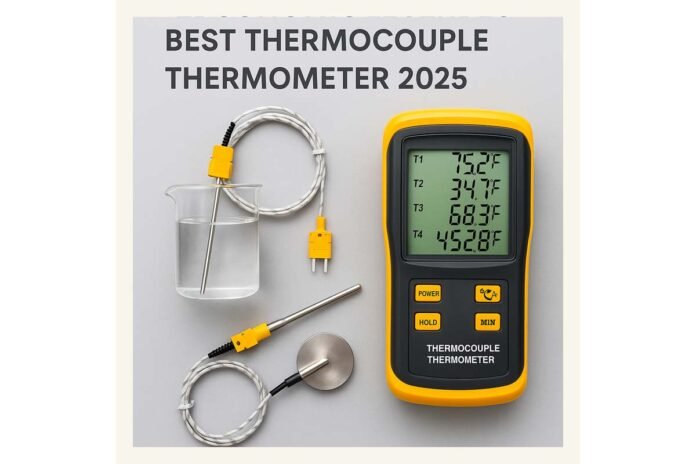Looking to measure extreme temperatures with precision? Whether you’re working in HVAC, metal fabrication, industrial environments, or labs, a thermocouple thermometer is your go-to tool. In this guide, we’ll break down what a thermocouple thermometer is, how it works, why calibration is crucial, and introduce our top pick for 2025 that balances performance and affordability.
What Is the Best Thermocouple Thermometer and How Does It Work?
How It Works
A thermocouple thermometer is a type of temperature-sensing device that uses two dissimilar metal wires joined at one end. When the junction is heated or cooled, it produces a small voltage that corresponds to the temperature at that point. This voltage is then interpreted by the thermometer and displayed as a temperature reading.
Among thermocouples, Type K is the most commonly used in the U.S. due to its wide temperature range and affordability. Type K thermocouples can typically measure from -328°F to over 2500°F, making them ideal for demanding environments.
Common Use Cases
Thermocouple thermometers are widely used across industries:
- 🔧 HVAC technicians for duct and pipe temperature readings
- ⚙️ Automotive and mechanical diagnostics
- 🧪 Scientific and industrial labs for high-temperature reactions
- 🔥 Metalwork and welding shops for precise thermal control
- 🍳 Occasionally in commercial kitchens, though food-grade probes are required
They’re valued for their durability, fast response time, and ability to withstand extreme conditions.
Why Calibrating Your Thermocouple Thermometer Matters
Temperature Accuracy and Compliance
Even the best thermocouple thermometer can lose accuracy over time due to wear, oxidation, or electronic drift. That’s why regular calibration is essential—especially in professional settings where small temperature errors can lead to big consequences (e.g., failed quality control or safety risks).
Proper calibration ensures:
- Accurate readings across the device’s full range
- Compliance with industry standards (like ISO, NIST, or FDA requirements)
- Reliable long-term performance
Calibration Methods
There are several ways to calibrate a thermocouple thermometer:
- 🧊 Dry-Well Calibrator – A block of metal heated to precise temperatures. Ideal for industrial applications.
- 💧 Micro-Bath – A stirred liquid bath offering more uniform heat, great for irregular or small probes.
- 🛠️ DIY Method – Using boiling/ice water or a controlled hot water bath to test accuracy with a multimeter.
We’ll walk you through a simple calibration process in the next section.
How to Calibrate a Thermocouple Thermometer
Calibrating a thermocouple thermometer doesn’t require expensive lab equipment. In fact, you can do a basic but effective DIY calibration at home or in a small workshop using a water bath and a multimeter. Here’s how.
Step-by-Step DIY Calibration Guide
When calibrating the best thermocouple thermometer for lab or industrial use, make sure to cross-check your voltage measurements with the 🔗 NIST Thermocouple Reference Table to ensure precision.
What You’ll Need:
- A thermocouple thermometer (Type K or similar)
- A digital multimeter that reads millivolts
- A container (heat-safe glass or metal)
- A stove or hot plate
- Water
- A thermometer with known accuracy (optional, for verification)
Calibration Process:
- Fill the container with water and place it on a stove or hot plate.
- Heat the water gradually to approximately 30°C (86°F). Stir occasionally for even temperature.
- Insert the thermocouple probe into the water, ensuring the junction is fully submerged but not touching the container sides.
- Connect the thermocouple leads to your multimeter or the device’s terminal.
- Allow the voltage to stabilize, then record the output millivolts or displayed temperature.
- Increase the temperature in 5°C increments (e.g., 35°C, 40°C…) up to around 60°C (140°F).
- Record the voltage or temperature at each step.
- Compare your readings to a Type K voltage-temperature chart (or manufacturer specs).
- Note any deviation from expected values—this helps you determine if adjustment or professional recalibration is needed.
Tip:
- Room temperature voltage should also be measured as a control. Type K thermocouples typically increase by ~40 µV per °C.
- If your thermometer has a manual offset or calibration mode, use your deviation data to adjust it for better accuracy.
Calibrating a thermocouple thermometer doesn’t have to be complicated. The infographic below shows a simple DIY calibration method using a water bath, a multimeter, and a Type K thermocouple probe. You can follow this method to check accuracy and adjust for any voltage deviation compared to standard reference charts.

Tools That Make Calibration Easier:
While the DIY method works, professionals may prefer using:
- ✅ Dry-Well Calibrators – Fast heat-up time and precision
- ✅ Micro-Baths – Ideal for odd-shaped or short probes
- ✅ Milliamp Calibrators – For advanced voltage diagnostics and gain correction
These tools help ensure linearization across the entire temperature range and are often used in industries where compliance is critical.
🔽 Next: Let’s look at our Top Pick thermocouple thermometer for 2025 — including key features, who it’s best for, and where to get it.
Buyer’s Top Pick: RISEPRO 4-Channel Type K Thermocouple Thermometer
If you’re looking for an affordable, multi-input thermocouple thermometer that delivers solid performance, the RISEPRO 4-Channel Type K Thermometer stands out in 2025. It’s ideal for anyone needing to measure multiple temperatures at once—from HVAC professionals to lab technicians and metalworkers.
🔧 Key Features & Specs
| Feature | Details |
|---|---|
| Thermocouple Type | Type K |
| Inputs | 4-channel support (simultaneous readings) |
| Temperature Range | -328°F to 2501°F (-200°C to 1372°C) |
| Accuracy | ±0.1% + 1°F |
| Display | Large backlit LCD with °C / °F / K switching |
| Power-Saving Mode | Auto shut-off after 5–10 minutes |
| Probe Length | 40 inches (with plastic handle, 2mm tips) |
| Resolution | <1000°C: 0.1°C/°F/K; >1000°C: 1°C/°F/K |
This thermometer supports a wide range of probes—including exposed metal thermocouple wires for testing hot surfaces and machinery.
✅ Pros & Cons
Pros:
- Supports up to 4 probes at once — great for multi-zone diagnostics
- Wide temperature range – covers almost all industrial and mechanical needs
- Easy-to-read LCD with unit switching (°C / °F / K)
- Lightweight and portable
- Very affordable for its feature set
Cons:
- Basic build quality – not ideal for harsh environments
- Probes included are not suitable for metal surfaces – you’ll need to buy metal tip K-type probes separately
- No wireless or app integration (for those who need remote logging)
👤 Who It’s Best For
This thermometer is best for:
- HVAC professionals needing to measure pipe, duct, or vent temperatures
- Engineers and mechanics monitoring machine temperatures
- DIYers working with metal fabrication or electronics
- Teachers or lab techs in educational or research settings
It’s not ideal if you need smart connectivity or food-grade probes for culinary applications.
🔗 Check Price on Amazon
👉 Affordable, accurate, and practical for pros and hobbyists alike.
🎯 Next up: In the conclusion, we’ll summarize why this thermometer is a solid choice — and answer some frequently asked questions to help you decide with confidence.
Final Thoughts
If you need a reliable, affordable way to measure high temperatures across multiple zones, the RISEPRO 4-Channel Type K Thermocouple Thermometer is a strong pick for 2025. It combines practical features—like multi-probe support and wide temp range—with a price that makes sense for pros and hobbyists alike.
While it doesn’t have the bells and whistles of high-end lab equipment, it nails the essentials: accuracy, simplicity, and versatility. Just be sure to grab exposed metal K-type probes if you plan to measure hot metals or machines.
➡️ Click here to check the current price on Amazon
❓ Frequently Asked Questions (FAQ)
What is the difference between a thermocouple and a thermometer?
A thermocouple is a sensor that generates a voltage based on temperature, while a thermometer is a device that reads and displays that data. A thermocouple thermometer combines both functions.
How accurate are thermocouple thermometers?
Accuracy depends on the type and calibration. A properly calibrated Type K thermocouple typically offers ±0.1% + 1°F accuracy, making it suitable for most industrial, HVAC, and technical applications.
Can I use this for cooking or food safety?
Not out of the box. The RISEPRO unit comes with plastic-handle probes meant for mechanical use. For food-grade applications, you’d need special food-safe thermocouple probes, and a thermometer certified for food use.
Do I need to calibrate my thermocouple thermometer regularly?
Yes. Especially if used in critical applications or exposed to extreme environments. You can do basic calibration using hot water and a multimeter, or invest in a dry-well calibrator for precision.
What type of thermocouple is best?
Type K is the most common and versatile thermocouple type, ideal for a wide range of temperatures and environments. It’s affordable, widely supported, and works well in most technical use cases.
🎯 Need more guidance? Check out our related articles:





